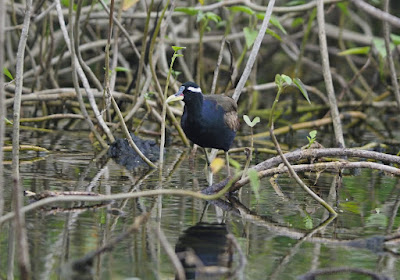October 2020
The first lockdown with a very strong monsoon in 2020 pretty much ensured that any exploratory intentions I had was drowned in the deluge. Not wanting to get my gear wet and also the desire to avoid confrontations with the keepers of the law, I didn't move out much after that preliminary trip in July. By October the intensity of the lockdown was relaxed a bit and restrictions on movement was also not being imposed too strictly. As the monsoon was on the wane I decided that my exploratory trips could restart. How much difference a three month gap makes to life in a pond was revealed to me then!
Malampuzha reservoir was brimming and most water bodies were full. Migrants had already reached in expected places but Malampuzha was proving to be a disappointment for the ducks and snipes as the water levels had not started receding. However the ponds were teeming with new life.
 |
| Common kingfisher |
 |
| Eurasian moorhen |
When, I returned to the Polpully pond, I was greeted by a heart-warming sight. The whistling ducks had a family!
 |
 |
| Lesser whistling ducks |
The adults were escorting two 'zebra' costumed chicks. It appeared that they were the only surviving chicks from a larger brood. The parents were on high alert looking skyward when a kite took a glide that seemed too close for comfort. It seemed that the threat wasn't only from the air but also from neighbours!
In the middle of foraging, one of the pair suddenly took off and landed in the middle of three other ducks which seemed to have swam too near the chicks.
The intruders, taken by surprise at the intensity of the attack, scattered in all directions.
The scuffle finished as quickly as it started but the provocation for the attack was a mystery to me. Were the parents under the impression that the approaching ducks were a threat to the two chicks? Did the strangers have any malafide intentions, perhaps kidnapping the chicks? I couldn't quite figure out the reason for the unprovoked threat display.
Within seconds, all was calm and the chicks and parents continued foraging again as though nothing happened.
I hoped that the two chicks would survive in that tough environment. While researching about chick survival rate, I was surprised that there is scanty information specific to this species. From available information (link here) and other sites it seems that the number of eggs laid is on the higher side (8 to 14) and this is probably to offset the low chick survival rates.
The chicks in this location were probably vulnerable to predation as starvation in this pond seemed unlikely. There were kites, serpent eagles, herons, snakes and turtles sharing space around the same pond with the ducks. It was therefore quite possible that the other chicks, who seem to have a tendency to wander off , may have fallen prey to one of them.
The pond was also home to a family of bronze-winged jacanas who also had a juvenile with them. The young bird would have also been a Survivor as the usual clutch for this species is 3 to 4 eggs.
 |
| Bronze-winged jacana |
 |
| Bronze-winged jacana juvenile |
 |
| The Survivor |
Monsoon in the pond seems an interesting period and the activity in the pond should be worth watching. Three different species were seen courting and two had raised families in the monsoon season. There were other birds around the pond and as long as the habitat remained undisturbed there would be surprises in the coming seasons!
This is the second post in the series, 'Waters of Life'. The first part is here.











No comments:
Post a Comment